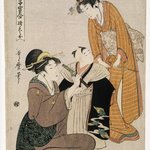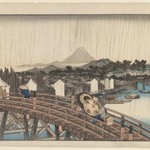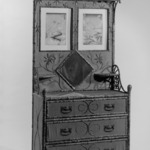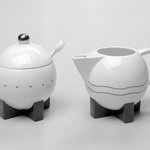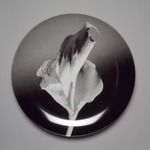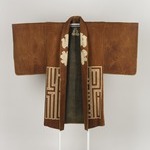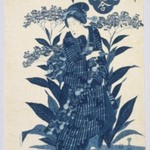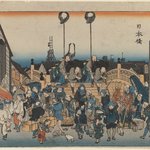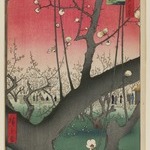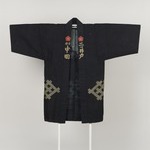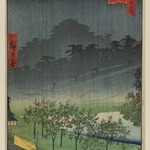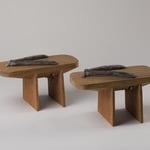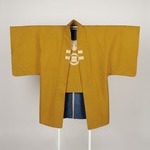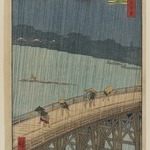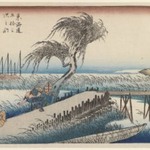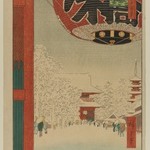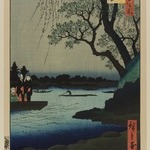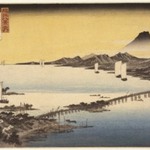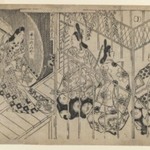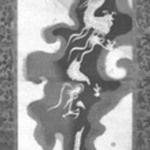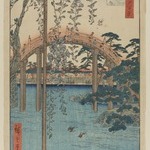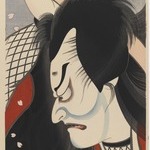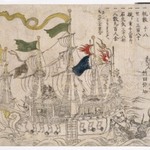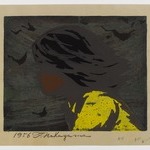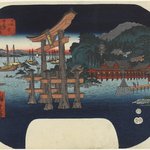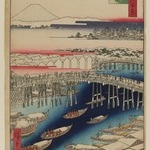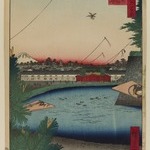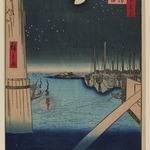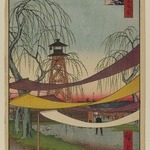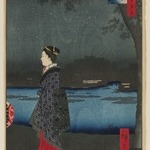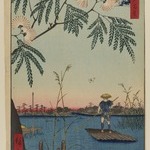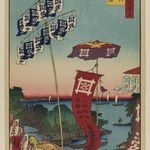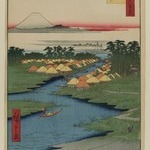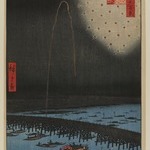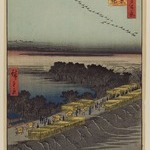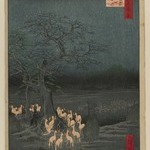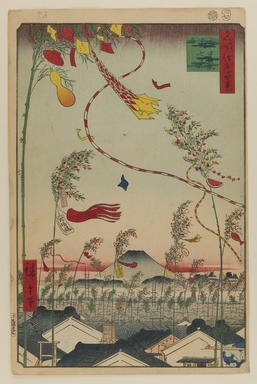
The City Flourishing, Tanabata Festival, No. 73 from One Hundred Famous Views of Edo
Utagawa Hiroshige
Asian Art
The Tanabata Festival, celebrated annually on the seventh day of the Seventh Month, derived from an ancient Chinese legend about the Celestial Weaving Girl (the star Vega) who crosses the Milky Way once a year to meet her beloved Cowherd (Altair). By the late Edo period, the Festival had developed into a huge outdoor display of inscribed, multicolored sheets of paper and auspicious paper symbols attached to long green bamboo poles. Although this is the only print in the series that does not specify a place in the title, it represents the view from a very specific, very personal place: Hiroshige's own house.
MEDIUM
Woodblock print
DATES
7th month of 1857
PERIOD
Edo Period, Ansei Era
DIMENSIONS
Sheet: 14 3/16 x 9 1/4 in. (36 x 23.5 cm)
Image: 13 3/8 x 8 3/4 in. (34 x 22.2 cm) (show scale)



MARKINGS
Publisher: Shitaya Uo Ei
SIGNATURE
Hiroshige-ga
COLLECTIONS
Asian Art
ACCESSION NUMBER
30.1478.73
CREDIT LINE
Gift of Anna Ferris
PROVENANCE
Prior to 1930, provenance not yet documented; by 1930, acquired by Anna Ferris of Summit, NJ; 1930, gift of Anna Ferris to the Brooklyn Museum.
Provenance FAQ
CATALOGUE DESCRIPTION
The name of the Tanabata festival, short for Tanabatatsume, "weaving girl," was derived from an ancient Chinese legend about a Celestial Weaving Girl (the star Vega) who on the seventh day of the seventh month could cross the Milky Way to meet her lover. The day was first marked by Japanese aristocracy in the Nara period and in Edo the shogunate celebrated Tanabata as one the auspicious Five Festivals. In rural areas, the festival included prayers for a bounteous crop, and in urban areas, prayers for skill in calligraphy. Thus came about the practice of writing poems on slips of paper that were hung on bamboo branches as offerings to the two star-lovers. As seen, long green bamboo poles were tied to rooftop ladders and from these poles were hung slips of paper of many colors inscribed with poems. At the top is a cutout of a fishnet, an emblem of bounty, and next to it a sake cup and gourd flask (it is known that Hiroshige loved sake). Below, to the left, are merchant items: an abacus, an accounts ledger, and a money chest marked "one thousand gold ryo," and to the right are a string of ground-cherry fruits, a slice of watermelon, and a fish. An entry in the "Buko Nenpyo" notes that the bamboo poles were particularly numerous in 1873, the year that the official festival was abolished, to be replaced by the Western calendar and by the new imperial celebrations.
This print is the first of the "Autumn" section of the series, and the snowless crest of Fuji suggests that it was quite warm. It is the only print in the entire series that does not indicate a specific place in the title, (the "shichu" in the title is "throughout the city"). However, this print is in fact a view from Hiroshige's own house in Nakabashi Kano Shinmichi, just east of the main Tokaido avenue; the place today is marked by a plaque. In the distance to the right is the fire tower marking the Yayosu barracks of the shogunal firefighters, where Hiroshige was born, raised, and lived until he was forty-three. The warehouses below belong to the merchants of Minami Denma-cho, just west of Hiroshige's house.
EXHIBITIONS
MUSEUM LOCATION
This item is not on view
CAPTION
Utagawa Hiroshige (Japanese, 1797–1858). The City Flourishing, Tanabata Festival, No. 73 from One Hundred Famous Views of Edo, 7th month of 1857. Woodblock print, Sheet: 14 3/16 x 9 1/4 in. (36 x 23.5 cm). Brooklyn Museum, Gift of Anna Ferris, 30.1478.73 (Photo: Brooklyn Museum, 30.1478.73_PS20.jpg)
IMAGE
overall, 30.1478.73_PS20.jpg. Brooklyn Museum photograph, 2023
"CUR" at the beginning of an image file name means that the image was created by a curatorial staff member. These study images may be digital point-and-shoot photographs, when we don\'t yet have high-quality studio photography, or they may be scans of older negatives, slides, or photographic prints, providing historical documentation of the object.
RIGHTS STATEMENT
No known copyright restrictions
This work may be in the public domain in the United States. Works created by United States and non-United States nationals published prior to 1923 are in the public domain, subject to the terms of any applicable treaty or agreement.
You may download and use Brooklyn Museum images of this work. Please include caption information from this page and credit the Brooklyn Museum. If you need a high resolution file, please fill out our online application form (charges apply).
The Museum does not warrant that the use of this work will not infringe on the rights of third parties, such as artists or artists' heirs holding the rights to the work. It is your responsibility to determine and satisfy copyright or other use restrictions before copying, transmitting, or making other use of protected items beyond that allowed by "fair use," as such term is understood under the United States Copyright Act.
The Brooklyn Museum makes no representations or warranties with respect to the application or terms of any international agreement governing copyright protection in the United States for works created by foreign nationals.
For further information about copyright, we recommend resources at the United States Library of Congress, Cornell University, Copyright and Cultural Institutions: Guidelines for U.S. Libraries, Archives, and Museums, and Copyright Watch.
For more information about the Museum's rights project, including how rights types are assigned, please see our blog posts on copyright.
If you have any information regarding this work and rights to it, please contact copyright@brooklynmuseum.org.
RECORD COMPLETENESS
Not every record you will find here is complete. More information is available for some works than for others, and some entries have been updated more recently. Records are frequently reviewed and revised, and we welcome any additional information you might have.
